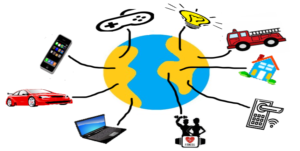Every text you read on The Enthusiast Place aim to provide you the best information and help you making good choices. Things you buy through our links may earn us a commission.
Nowadays there has been an increasing demand for the development of applications for the internet. The IoT, Internet of things, is one of the main technologies that enhances the creation of applications with practical utility on the internet.
Internet of Things definition
The internet of things, with the acronym IoT, is nothing more than a network of objects linked together through the infrastructure composed of routers and other interconnected devices that allow connection to the internet.
In this way, objects gain the ability to communicate with each other, at any distance and in any part of the world, taking advantage of the existing communication infrastructure that is the internet.
The advantage of Internet of Things
Without the need for additional cables and connections, the Internet of Things is an intelligent solution that allows remote access to physical devices and also reduces human effort in several routine tasks. This concept also allows the creation of autonomous controls so that some devices can control other devices without any human intervention.

In the Internet of Things concept, “things” are a bit of everything, a hodgepodge of software, hardware. In the Internet of Things concept, “things” are a mix of software, hardware and data. From a GPS locator installed in a vehicle that communicates your position to the transport hub, your scale that communicates your weight and body mass index for registration on your smartphone, everything can be interconnected to make our lives easier.
Click here to read more about the history of the Internet of Things.
Some examples of Internet of Things
An example often used in large companies is the access control to offices or warehouses, a card reader interconnected with the human resources database that allows not only the employee to enter the space but also to record all entries and exits. with their schedule.
In public transport, a bus that communicates its position and occupancy rate in real time, allowing the central to send a second bus immediately in case of breakdown or excess passengers and the bus stops that receive information from the central and are able to give information to passengers about how much time is left to get transport.
In medicine, when a patient can be followed up and monitored remotely as known as telemetry, and even allowing the administration of medications in the correct dose when necessary, without having to move the nurse to the place.
Smart home appliances are also a good example of internet of things applications, actually allowing you to control lights, temperature, windows and door opening, and also connected devices like video surveillance, security alarms, and smoke, flood and gas sensors.
These are just a few examples of useful IoT applications already in use today.
Do you think this is all very futuristic or have you seen examples in practice, can you imagine what else will be introduced in the future? I invite you to share your experiences, fears or even visions of the future about this fantastic world in which we live.